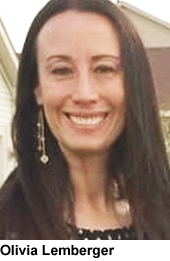Every day, nurses find ways to improve patient care.
 The author writes, “If you have ever thought of a better way to do something or realized that a current process needs improvement, you are an innovator.”
The author writes, “If you have ever thought of a better way to do something or realized that a current process needs improvement, you are an innovator.”
 In 1997, I had the honor of becoming a Peace Corps volunteer in Guinea, West Africa. I had just graduated from Marquette University in Milwaukee, Wisconsin, USA, with my Bachelor of Science in Nursing degree and wanted to grow my healthcare knowledge in an unfamiliar and challenging setting. I was placed in a remote village—the only Peace Corps volunteer—with no electricity or running water, and I spent most of my time in a hut that served as the village clinic.
In 1997, I had the honor of becoming a Peace Corps volunteer in Guinea, West Africa. I had just graduated from Marquette University in Milwaukee, Wisconsin, USA, with my Bachelor of Science in Nursing degree and wanted to grow my healthcare knowledge in an unfamiliar and challenging setting. I was placed in a remote village—the only Peace Corps volunteer—with no electricity or running water, and I spent most of my time in a hut that served as the village clinic.
There I was confronted with leprosy, yellow fever, and malaria—as well as many other diseases I had never encountered during my clinical experiences in nursing school.
At that time, the healthcare system in Guinea lacked essential resources. Needles, for instance, were in short supply. The first time I injected a patient with a used needle was devastating. Before reusing needles—to administer polio vaccines, for example—I boiled them in water over an open fire, praying I wasn’t causing more harm than good.
Determined to find a better way, I began thinking outside the box. To improve the way healthcare was delivered, I asked my fellow villagers to share their experiences with me, solicited their opinions, and began changing certain practices. Looking back, that was when I began to innovate.
Better ways
The English word “innovation” is derived from the Latin word “innovatus,” which means initiation of a new method in a social, administrative, or cultural environment. Nursing is built on a strong foundation of innovation, demonstrated through extraordinary stories. Florence Nightingale invented the polar-area diagram, a statistical tool used to track infection rates during the Crimean War. It is still used today. Anita Door, an emergency department nurse frustrated with continual gathering of supplies during emergent situations, invented the crash cart. Sister Jean Ward, a charge nurse in the nursery at Rochford Hospital in Rochford, Essex, UK, observed that babies positioned closer to the window and exposed to more sunlight had fewer incidents of jaundice. Her innovation? Contemporary phototherapy.
Nurses have innovated on behalf of social justice, inclusion, and reform. In 1979, Joe Hogan, a registered nurse who wanted to earn his bachelor’s degree in nursing, was denied admittance to Mississippi University for Women, at that time the only local institution offering the degree. Claiming that his 14th Amendment rights under the U.S. Constitution were violated, he sued. In 1982, the U.S. Supreme Court ruled in his favor, ending gender discrimination at publicly funded nursing schools in the United States.
Ruth Nita Barrow, a nurse practitioner from Barbados, was the only woman on a team of social advocates who went to South Africa to negotiate the release of Nelson Mandela. In advocating for Mandela, Barrow was instrumental in securing his release from prison, precipitating the end of apartheid. In 1984, Claire Bertschinger, a nurse with the Red Cross in Ethiopia, was helping children affected by famine. An interview of her by the BBC inspired Bob Geldof to create Band Aid, a live music fundraiser. Band Aid inspired Live Aid in the United States, which released in 1985 the song “We Are the World.” One of the largest philanthropic music events in history, Live Aid saved more than 2 million lives in Africa.
Embracing our legacy
Every day, nurses create better ways to improve patient care. Unfortunately, nurses do not think of themselves as innovators. Within our profession, there is a disconnect between realizing “we could do this better” and turning that idea, whatever it may be, into reality. If you have ever thought of a better way to do something or realized that a current process needs improvement, you are an innovator.
Students in disciplines such as engineering, business, and computer technology are taught that their ideas matter. The curricula established for these disciplines plant seeds of innovation early, encouraging creativity to flourish. From the start, these students are taught to believe they can make a difference, and they are given tools that nurture creativity, explore opportunities, and promote innovation.
Nurses don’t realize they are innovators because, as a profession, we have not embraced our legacy of innovation. We don’t intentionally consider where we are going with innovation because we haven’t embraced where we have been. On a daily basis, nurses find solutions and create ways to improve patient care. The problem is, many of these amazing innovations don’t make it out of the unit where they were created. Nurses are innovators, but often their creations are not disseminated or shared on a larger scale.
I didn’t know that!
After working in the emergency department for 16 years, I was intrigued to learn that an emergency room nurse invented the crash cart. I was even more amazed when I shared this story with my colleagues and realized that not a single person had heard it. I told the crash cart story to fellow educators at my university, and again, no one had heard about it. So I decided to explore nursing innovation further and immersed myself in learning more about the amazing accomplishments carried out by our profession’s unsung heroes.
My curiosity took me deep into the history of nursing, beginning with Florence Nightingale. The Lady with the Lamp, the founder of modern nursing, modeled innovative behavior. Using bells, she invented what became the call-light system. She also innovated physician-nurse rounding and modern sanitation practices, and she was the first to insist on a food delivery system within the hospital.
After examining nursing’s history of innovation, I began to explore innovation from an interprofessional healthcare perspective. Innovation asks, “How can we, as a healthcare team, learn together to find innovative solutions to everyday problems that will increase healthcare quality and improve patient outcomes?”
We need to create a culture of innovation
From there, to more fully understand the impact and magnitude of innovation on organizations, I began looking outside nursing and healthcare to other industries—including globally. To understand the potential for innovation, it is important to consider its environment, communication patterns, employee behavior characteristics, resources, stakeholder utilization, and ability to tolerate failure.
Ability to innovate is a humanitarian necessity in many parts of the world. Creating a nebulizer operated with a bicycle air pump is an innovative and sustainable solution for saving lives of people with asthma who don’t have access to electricity. I was ecstatic to discover the innovation of solar-powered sterilization. Using the sun instead of electricity to sterilize equipment will bring improved healthcare outcomes to remote areas of the world. Future healthcare volunteers won’t have to deal with the impossible dilemma I faced 21 years ago in Guinea doing my best to sterilize equipment and not knowing if I had succeeded.
It’s time we share our collective nursing history and revel in our professional accomplishments. The narrative pedagogy of our profession needs to include the myriad of success stories about how nursing innovations have positively changed the world. We need to share these stories of perseverance and determination. My deepest hope is that, as nurses, we begin to realize our collective worth as innovators and nurture the insights and creativity of those within our profession. RNL
“Nursing, is above all, a progressive calling. Year by year nurses have to learn new and improved methods, as medicine and surgery and hygiene improve. Year by year nurses are called upon to do more and better than they have done.”
—Florence Nightingale
Olivia Lemberger, MSN, RN, CHSE, is clinical educator at Rush Copley Hospital in Aurora, Illinois, USA, and a doctoral student in the Health Sciences program at Northern Illinois University, DeKalb, Illinois, USA.
Editor’s note: Olivia Lemberger will present “An Integrative Review of Cross-Industry Global Innovation: Evidence-Based Strategies for Nursing Practice” on Saturday, 21 July 2018, at Sigma’s 29th International Nursing Research Congress in Melbourne, Australia. Register here for congress.
© 2018 Olivia Lemberger